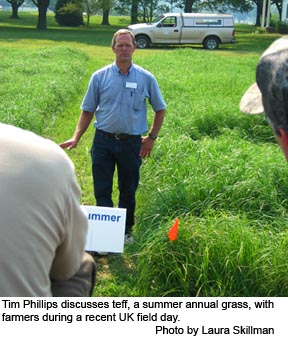Teff May Be a Summer Forage Option
Teff May Be a Summer Forage Option

The heat of summer often leaves pastures and hayfields floundering and farmers looking for other options for livestock forages. Teff, an African grass, could hold some promise.
Teff is a warm season grass utilized as a grain crop in Africa. It can grow more than four feet tall and produce more than six tons per acre per year. It is a very small, seeded grass relatively easy to establish. Teff also is known as summer love grass or annual love grass.
Tim Phillips, a fescue breeder for the University of Kentucky College of Agriculture first used it in rotations to suppress weeds where he’d later be planting fescue in the fall. He has also been conducting some research on this grass to determine its worthiness for Kentucky farmers and highlighted some of his findings during a recent UK field day.
“The seeds are really, really small – about 1.3 million per pound. It makes timothy and white clover look big,” he said. “About 100 years ago it began being used as a forage crop in South Africa, so it’s not new as a forage, but it is a somewhat new summer annual forage grass option for us in Kentucky.”
A major threat to the grass is frost, he said. Frost will completely kill it. Seeds must be planted in spring after the risk of frost has passed. It is recommended that about six pounds of seed per acre be planted into a firm seedbed at a depth of one-eighth to one-quarter of an inch. Sixty pounds of nitrogen should be applied at seeding. The grass does not reseed itself.
With good rainfall, seed distribution, and if it’s not seeded too deep, farmers can expect a good stand. However, if the seed sits there waiting to germinate for too long, weeds may begin to grow reducing the quality of the stand. A good stand will suppress weed growth.
The grass needs to be cut to a three- to four-inch stubble height before it develops seed heads for the best quality. It has good regrowth and typically, it can be cut again within five to seven weeks. Tests have shown the leaf to contain 20 percent protein and have a 107 relative feed value. The other nutrients elements are similar to timothy, Phillips said.
“You can get multiple cuttings if you don’t wait too long and let it head out. It’s much better than what you see in typical summer annual grasses such as sorghum and sudan, which
are much taller, coarser and thick stemmed,” he said. “A lot of them are much bigger and take longer to dry. Plus they take more nitrogen and the forage quality is not as good.”
Typically, a farmer can expect to get two and a half to three tons per acre per cutting if they get three inches of rain per month, fertilize it and keep the weeds under control. That could mean five to seven tons of hay per acre from the annual grass. So far, there have been few disease or insect problems. There are several seed varieties available.
Last summer, they grazed some of it after first cutting it for hay. Phillips said it is important to have a firm seedbed otherwise the cattle can pull it out of the ground. On this trial, heifers grazed it down to stems before moving to a fescue plot, he said.
